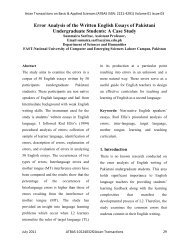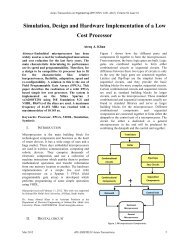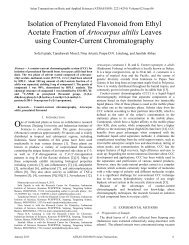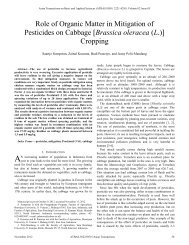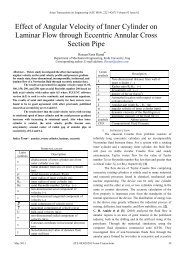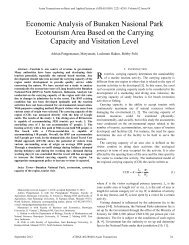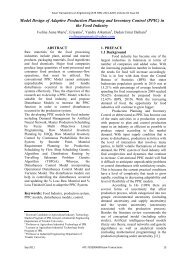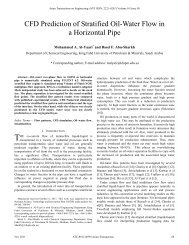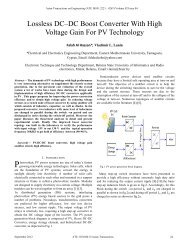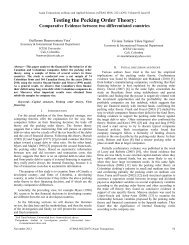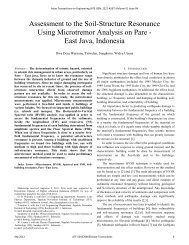Modal Parameter Extraction Based on Hilbert Transform of - Asian ...
Modal Parameter Extraction Based on Hilbert Transform of - Asian ...
Modal Parameter Extraction Based on Hilbert Transform of - Asian ...
You also want an ePaper? Increase the reach of your titles
YUMPU automatically turns print PDFs into web optimized ePapers that Google loves.
<strong>Asian</strong> Transacti<strong>on</strong>s <strong>on</strong> Engineering (ATE ISSN: 2221-4267) Volume 02 Issue 01<str<strong>on</strong>g>Modal</str<strong>on</strong>g> <str<strong>on</strong>g>Parameter</str<strong>on</strong>g> <str<strong>on</strong>g>Extracti<strong>on</strong></str<strong>on</strong>g> <str<strong>on</strong>g>Based</str<strong>on</strong>g> <strong>on</strong> <strong>Hilbert</strong> <strong>Transform</strong> <strong>of</strong><str<strong>on</strong>g>Modal</str<strong>on</strong>g> Resp<strong>on</strong>sesZheng Min*, Shen Fan***College <strong>of</strong> Civil Aviati<strong>on</strong>, Nanjing University <strong>of</strong> Aer<strong>on</strong>autics and Astr<strong>on</strong>autics, China**College <strong>of</strong> Aerospace Engineering, Nanjing University <strong>of</strong> Aer<strong>on</strong>autics and Astr<strong>on</strong>autics, China*zhengminsf@163.com, **shen0039@ntu.edu.sgAbstract—Two modal identificati<strong>on</strong> methods based <strong>on</strong><strong>Hilbert</strong> <strong>Transform</strong> <strong>of</strong> modal resp<strong>on</strong>ses are used to extractmodal parameters <strong>of</strong> a structure in this paper. First, theaccelerati<strong>on</strong> resp<strong>on</strong>se time history polluted by noises isprocessed using Empirical Mode Decompositi<strong>on</strong> withSingular Value Decompositi<strong>on</strong>. Then, the frequencies anddamping ratios <strong>of</strong> the system can be estimated byperforming <strong>Hilbert</strong> <strong>Transform</strong> for obtained modalresp<strong>on</strong>ses. The mode shapes can be achieved when theresp<strong>on</strong>ses at all degrees <strong>of</strong> freedom are measured. Theproposed methods are illustrated using a simulated airplanemodel with dense modes built in ADAMS (AutomaticDynamic Analysis <strong>of</strong> Mechanical Systems) s<strong>of</strong>tware. Thesimulati<strong>on</strong> results dem<strong>on</strong>strate that the outlined twomethods based <strong>on</strong> <strong>Hilbert</strong> <strong>Transform</strong> can identify modalparameters well with the help <strong>of</strong> EMD and SVD as signalpreprocessor even for the structure with the closely spacemodes, low-energy comp<strong>on</strong>ents.Index Terms—modal analysis, <strong>Hilbert</strong> transform, EmpiricalMode Decompositi<strong>on</strong>, signal processingI. INTRODUCTION<str<strong>on</strong>g>Modal</str<strong>on</strong>g> analysis approach is an important tool forexperimental identificati<strong>on</strong> <strong>of</strong> a structural dynamicsmodels. Identified parameters can be used for design <strong>of</strong>active and passive c<strong>on</strong>trol <strong>of</strong> structures and structuralhealth m<strong>on</strong>itoring [1].There are numerous approaches that can be applied toextract modal parameters <strong>of</strong> structure. Traditi<strong>on</strong>ally,modal parameters are extracted by performing thereducing and curve-fitting procedures either <strong>on</strong> series <strong>of</strong>measured frequency resp<strong>on</strong>se functi<strong>on</strong> or <strong>on</strong> timeresp<strong>on</strong>se, such as impulse resp<strong>on</strong>se functi<strong>on</strong> [2] andfree-decay resp<strong>on</strong>se [3]. Recently modal analysis based<strong>on</strong> output-<strong>on</strong>ly, which has gained more and moreattenti<strong>on</strong>, can be d<strong>on</strong>e by utilizing the correlati<strong>on</strong>functi<strong>on</strong>s and power spectra <strong>of</strong> the operating data [4].Some time–frequency analysis tools, such asWigner–Ville distributi<strong>on</strong>, Wavelet <strong>Transform</strong> (WT) and<strong>Hilbert</strong>–Huang <strong>Transform</strong> (HHT) [5] building <strong>on</strong>Empirical Mode Decompositi<strong>on</strong> (EMD) and <strong>Hilbert</strong>spectral analysis (HSA) also have been used for systemidentificati<strong>on</strong> [6], damage detecti<strong>on</strong> [7]-[10] and etc [11].For example, the vibrati<strong>on</strong> resp<strong>on</strong>ses are processed usingHHT for fault diagnosis [12-13], the damage featuresdetecti<strong>on</strong> <strong>of</strong> composite aircraft wing-box structures [14]and health m<strong>on</strong>itoring <strong>of</strong> civil structural models [15-16].HHT technique is also proposed to identifymulti-degree-<strong>of</strong>-freedom (MDOF) linear systems withintermittency criteria [17] or band-pass filtering <strong>on</strong> themeasured free vibrati<strong>on</strong> time histories [18]. In this paper,two modal identificati<strong>on</strong>s based <strong>on</strong> <strong>Hilbert</strong> <strong>Transform</strong>with EMD and SVD as preprocessor are applied toextract modal parameters <strong>of</strong> a simulated airplane modelwith closely spaced modes built in ADAMS s<strong>of</strong>tware forvalidating the modal identificati<strong>on</strong> capabilities.II. MODAL PARAMTER IDENTIFICATIONA. <str<strong>on</strong>g>Modal</str<strong>on</strong>g> Resp<strong>on</strong>seC<strong>on</strong>sidering a multi-freedom system, we can describethe behaviours <strong>of</strong> the system by the equati<strong>on</strong>s <strong>of</strong> moti<strong>on</strong>asM ( t)X ( t) C(t)X( t) K(t)X ( t) F(t)(1)where M(t) is the mass matrix, C(t) is the dampingmatrix, K(t) is the stiffness, F(t) is the vector <strong>of</strong> randomMar 2012 ATE-70209018©<strong>Asian</strong>-Transacti<strong>on</strong>s 25
<strong>Asian</strong> Transacti<strong>on</strong>s <strong>on</strong> Engineering (ATE ISSN: 2221-4267) Volume 02 Issue 01forcing functi<strong>on</strong>, X(t) is the vector <strong>of</strong> randomdisplacements.Using a modal transformati<strong>on</strong>Nx( t) q ( t)(2)j1and the orthog<strong>on</strong>ality <strong>of</strong> mode shapes, a set <strong>of</strong> equati<strong>on</strong>sin the modal co-ordinates can be given as follows2( ) 2 ( ) ( ) Tjj jj jj( ) /jjq t q t q t F t m (3)where q j (t) is the jth generalized modal co-ordinate, ξ jand ω j are, respectively, the jth modal damping ratio andmodal frequency,modal mass.j is the jth modal vector, mjj is the jthWith the assumpti<strong>on</strong> <strong>of</strong> the existence <strong>of</strong> normal modes,due to a single impulse input force f l (t) at the lth DOF,i.e. f l (t)=F 0 δ(t), for all j≠l, (3) can be written asand2q ( t) 2 q( t) q ( t) 0 (4)jjF q t e tj0( ) lj j j j tj cos( )2djjm 12jj1 2 2where j tan 2 j1 j 12j natural frequency,factor. , ω dj is thejj is the modal participati<strong>on</strong>ljThe impulse accelerati<strong>on</strong> resp<strong>on</strong>seDOF can be derived asNxpp pj j pjj1 j1 x ( t) q ( t) x ( t)From (5) we can obtainwhereN(5)t at the pth (6)j j t,sin , x t C e t (7)pj pl j dj pl jCF 0 pj ljpl,j (8)mjdj (9)pl, j j pl,jand is the phase difference between the pth elementpl,jand the lth element in the jth mode shape.B. Identificati<strong>on</strong>s <strong>of</strong> Natural Frequencies and DampingRatiosEmpirical Mode Decompositi<strong>on</strong> (EMD) method [8]can extract the properties <strong>of</strong> signals even with n<strong>on</strong>linearand n<strong>on</strong>-stati<strong>on</strong>ary characteristics by decomposing anycomplicated data set via EMD into a finite, <strong>of</strong>ten small,number <strong>of</strong> Intrinsic Mode Functi<strong>on</strong>s (IMFs) that admit awell-behaved <strong>Hilbert</strong> transform. In this paper, EMD isapplied to decompose themeasured accelerati<strong>on</strong>resp<strong>on</strong>se excited by a multi-comp<strong>on</strong>ent loading with theimpulse, harm<strong>on</strong>ic and noise properties to obtain modalresp<strong>on</strong>ses. C<strong>on</strong>sidering a system with an input signalapplied to the lth DOF, the measured accelerati<strong>on</strong>resp<strong>on</strong>sefollows:wheret z pat the pth DOF can be processed asN G H (10) z t x t x t x t r tp pj ph po pj1 g1 h1pjcomp<strong>on</strong>ents, x t are IMFs for impulse resp<strong>on</strong>secomp<strong>on</strong>ents. The IMFsxpht are IMFs for harm<strong>on</strong>icpj x t can be processedthrough the <strong>Hilbert</strong> transform to determine modalparameters <strong>of</strong> the system andxph t can be identifiedas arising from harm<strong>on</strong>ic excitati<strong>on</strong> with zero damping.The analytical signalwhere ()pjYpjY pjt <strong>of</strong> x pjt is given~( t) x( t) ix ( t)(11)pjx t is the <strong>Hilbert</strong> <strong>Transform</strong> <strong>of</strong> x tEquati<strong>on</strong> (11) also can be expressed aspj pj . pi, ji pj t (12)Y t A t e pjwhere A pj is the instantaneous amplitude and θ pj is theinstantaneous phase angle. Instantaneous modalMar 2012 ATE-70209018©<strong>Asian</strong>-Transacti<strong>on</strong>s 26
acc.(m/s 2 )acc.(m/s 2 )Amp<strong>Asian</strong> Transacti<strong>on</strong>s <strong>on</strong> Engineering (ATE ISSN: 2221-4267) Volume 02 Issue 0125III. SIMULATED EXPERIMENTAL CASE STUDYThe outlined two methods based <strong>on</strong> <strong>Hilbert</strong> <strong>Transform</strong>are applied to analyze the resp<strong>on</strong>se data acquired from asimulated test c<strong>on</strong>ducted in ADAMS. The modalparameters are extracted and compared with those fromADAMS s<strong>of</strong>tware.A. Descripti<strong>on</strong> <strong>of</strong> Test Structure and TestsAn airplane model with closely spaced modes built inADAMS is c<strong>on</strong>sidered. It is made <strong>of</strong> ir<strong>on</strong> and fivemillimeters thick. The model was fixed at the coordinateorigin. The accelerati<strong>on</strong> resp<strong>on</strong>ses were measured <strong>on</strong>ly inthe vertical directi<strong>on</strong> at 27 points for vertical excitati<strong>on</strong> attwo symmetrical excitati<strong>on</strong> points <strong>on</strong> the wingtip. Fig.1shows the test model and the distributi<strong>on</strong> <strong>of</strong> the 27measurement points. The locati<strong>on</strong> numbers werearranged counterclockwise with the beginning <strong>of</strong>airplane head.20151050-50 1 2 3 4 5 6 7 8 9 10time(s)Fig. 2. Time history <strong>of</strong> the excitati<strong>on</strong> signalA total <strong>of</strong> 5000 resp<strong>on</strong>se samples corresp<strong>on</strong>ding tosignal durati<strong>on</strong> <strong>of</strong> 10s with a sampling rate <strong>of</strong> 500 Hz atthe 27 locati<strong>on</strong>s were acquired simultaneously, whichresults in a bandwidth <strong>of</strong> 0–250 Hz. Fig.3 shows thetemporal waveform <strong>of</strong> the 9th locati<strong>on</strong> and its FFTspectrum, respectively.3000200010000-1000-2000-30000 1 2 3 4 5 6 7 8 9 10time(s)450400350300250Fig. 1. Airplane model built in ADAMS with indicati<strong>on</strong> <strong>of</strong> thedistributi<strong>on</strong> <strong>of</strong> measurement pointsAn input signal with the multi-comp<strong>on</strong>ent properties,which is composed <strong>of</strong> a sinusoidal harm<strong>on</strong>ic frequency at80 Hz and an impulse at the moment <strong>of</strong> 0.1 sec<strong>on</strong>d al<strong>on</strong>gwith the stati<strong>on</strong>ary white noise, was applied to the 2excitati<strong>on</strong> points. Fig.2 shows the time history <strong>of</strong> theexcitati<strong>on</strong> signal.2001501005000 50 100 150 200 250Frequence(Hz)Fig. 3. Time history and FFT spectrum <strong>of</strong> measured accelerati<strong>on</strong>resp<strong>on</strong>se at the 9th locati<strong>on</strong> <strong>of</strong> the airplane modelB. Signal ProcessingIn practical applicati<strong>on</strong>s, the closely space modesusually occur <strong>on</strong> some engineering structures. It is quitechallenging to extract characteristic parameters for suchstructures. SVD filtering is used to help EMD separateMar 2012 ATE-70209018©<strong>Asian</strong>-Transacti<strong>on</strong>s 28
Ampacc.(m/s 2 )acc.(m/s 2 )Ampacc.(m/s 2 )Amp<strong>Asian</strong> Transacti<strong>on</strong>s <strong>on</strong> Engineering (ATE ISSN: 2221-4267) Volume 02 Issue 01the dense modes in this paper.The SVD-decomposed subspaces are an orthog<strong>on</strong>alrepresentati<strong>on</strong> <strong>of</strong> the original space, the relevant discretetime series y w (k) (w=1,2,…s) corresp<strong>on</strong>ding to thesubspace w should have str<strong>on</strong>g correlati<strong>on</strong> with theoriginal signal. With the aid <strong>of</strong> the correlati<strong>on</strong>coefficients, a screening process will be c<strong>on</strong>ducted andthe selected vital time series y w (k) will be remained.After rec<strong>on</strong>structing the signal y rec (k) by superposingthe retained time series y w (k) as followingrec sw1w y k y k(27)We process it through the band-pass filters each with afrequency band near the possible frequencies <strong>of</strong> thesystem. Each filtered time history is decomposed byEMD, and the resulting first IMFs will be processedthrough the <strong>Hilbert</strong> transform for the identificati<strong>on</strong> <strong>of</strong>modal parameters [18].The modal resp<strong>on</strong>ses near the natural frequencies areshown in Fig.4. It can be seen that the 5 th selectedcomp<strong>on</strong>ent at 19 Hz that c<strong>on</strong>tains low-energy comp<strong>on</strong>entand the two closed space frequencies near the 3 th selectedcomp<strong>on</strong>ent at 52 Hz and the 2 nd selected comp<strong>on</strong>ent at54 Hz are clearly visible. It is noted that a segment <strong>of</strong> themodal resp<strong>on</strong>se near t =0 is not a decaying functi<strong>on</strong>mainly due to the phase shift. Such a segment should beremoved before the <strong>Hilbert</strong> transform is applied to thesemodal resp<strong>on</strong>ses to extract modal parameters <strong>of</strong> thesystem.60504030201000 50 100 150 200 250Frequence(Hz)(a)Time history and FFT spectrum <strong>of</strong> the 1 st selected comp<strong>on</strong>ent250200150100500-50-100-150-200-2500 0.1 0.2 0.3 0.4 0.5 0.6 0.7 0.8 0.9 1time(s)60504030201000 50 100 150 200 250Frequence(Hz)(b)Time history and FFT spectrum <strong>of</strong> the 2 nd selected comp<strong>on</strong>ent8006004002000150-200100-400-60050-8000 0.2 0.4 0.6 0.8 1 1.2time(s)0140-50120-10010080-1500 0.5 1 1.5 2 2.5 3 3.5 4 4.5 5time(s)60402000 50 100 150 200 250Frequence(Hz)Mar 2012 ATE-70209018©<strong>Asian</strong>-Transacti<strong>on</strong>s 29
Ampacc.(m/s 2 )AmpAmpacc.(m/s 2 )acc.(m/s 2 )<strong>Asian</strong> Transacti<strong>on</strong>s <strong>on</strong> Engineering (ATE ISSN: 2221-4267) Volume 02 Issue 01(c)Time history and FFT spectrum <strong>of</strong> the 3 rd selected comp<strong>on</strong>ent304000203000200010100000-10-1000-2000-20-3000-300 0.5 1 1.5 2 2.5 3 3.5time(s)-40000 0.2 0.4 0.6 0.8 1 1.2time(s)8600750065400430032002110000 50 100 150 200 250Frequence(Hz)(d)Time history and FFT spectrum <strong>of</strong> the 4 th selected comp<strong>on</strong>ent1086420-2-4-6-8-100 0.2 0.4 0.6 0.8 1 1.2 1.4 1.6 1.8 2 2.2time(s)21.81.61.41.200 50 100 150 200 250Frequence(Hz)(f)Time history and FFT spectrum <strong>of</strong> the 6 th selected comp<strong>on</strong>entFig. 4. Achieved modal resp<strong>on</strong>ses at the 9 th locati<strong>on</strong> through theproposed signal processing techniqueC. <str<strong>on</strong>g>Modal</str<strong>on</strong>g> Identificati<strong>on</strong>In order to avoid the bad influences <strong>of</strong> the phase shiftduring band-pass filtering and end effects <strong>of</strong> EMD <strong>on</strong>identified results, after removing the segment from t =0to the maximum amplitude each modal resp<strong>on</strong>se wereprocessed through the <strong>Hilbert</strong> transform to determine theinstantaneous amplitude and instantaneous phase. Theidentified results based <strong>on</strong> the resp<strong>on</strong>se at 9th positi<strong>on</strong>and the baseline models from ADAMS are listed inTable 1 for comparis<strong>on</strong> purposes.10.80.60.40.200 50 100 150 200 250Frequence(Hz)(e) Time history and FFT spectrum <strong>of</strong> the 5 th selected comp<strong>on</strong>entMar 2012 ATE-70209018©<strong>Asian</strong>-Transacti<strong>on</strong>s 30
<strong>Asian</strong> Transacti<strong>on</strong>s <strong>on</strong> Engineering (ATE ISSN: 2221-4267) Volume 02 Issue 01TABLE ITHE IDENTIFIED FREQUENCIES AND DAMPING RATIOSIn Table 1, we read that the identified harm<strong>on</strong>icfrequencies are 79.998 Hz and 80.053 Hz withcorresp<strong>on</strong>ding damping ratios <strong>of</strong> 0.02% and 0.01%Mode No.Frequencies(Hz)Damping Ratios(%)in method 1 and 2 respectively. Note that, althoughBase Method Method Base Method Methodthe damping should be zero in theory, it is verysmall in the results and therefore an analyst couldhardly be misled this pole as a true eigenpole <strong>of</strong> thesystem. The results also dem<strong>on</strong>strate that theproposed methods in this paper can identify themodal frequencies with great accuracy and thecorresp<strong>on</strong>ding damping ratios even when the densemodal frequencies exist near 52Hz. The modalparameters near the frequencies <strong>of</strong> 10Hz and 19Hzwith the low-energy, which are not clear in the FFTspectra <strong>of</strong> Fig.3, were extracted well. Generally, thedamping ratios from method 2 were less accuratethan those from method 1.123456Model10.26919.03643.66751.71753.79480110.27118.83343.72850.79752.85579.998210.28218.75943.84050.73652.93680.053Model0.590.621.031.491.16010.610.681.101.271.250.0220.700.811.151.211.330.01The results from the resp<strong>on</strong>ses <strong>of</strong> other locati<strong>on</strong>s al<strong>on</strong>eare very close to those based <strong>on</strong> the 9th <strong>on</strong>e. With theaccelerati<strong>on</strong> resp<strong>on</strong>ses at all positi<strong>on</strong>s measured, themode shapes <strong>of</strong> the system can be extracted. Theachieved mode shapes are visualized in Fig.5 with thetheoretical mode shapes for comparis<strong>on</strong>. It is observedthat the identified results have a good agreement with thebaseline model.25020015010050010006004005002000-200-4000 -600(a)The 1 st mode shapes25020050150100500010008006004002000-600-400-2000200400600-5010005000-600-400-2000200400600Mar 2012 ATE-70209018©<strong>Asian</strong>-Transacti<strong>on</strong>s 31
<strong>Asian</strong> Transacti<strong>on</strong>s <strong>on</strong> Engineering (ATE ISSN: 2221-4267) Volume 02 Issue 0150150105-50100005000-2000-400-600(b)The 2 nd mode shapes200400600-510005000-600 -400 -200 0 200 400 60086420-210005000-600 -400 -200 0 200 400 600(d)The 4 th mode shapes1050-5-10-1510005000-600 -400 -200 0 200 400 600251050-5-10-15100020151050-510005005000-600-400-20002004006000-600 -400 -200 0 200 400 600(c)The 3 rd mode shapes302520151050-510005000-600-400 -2000 200400 600(e)The 5 th mode shapesFig. 5. Identified mode shapes from the measured resp<strong>on</strong>sesMar 2012 ATE-70209018©<strong>Asian</strong>-Transacti<strong>on</strong>s 32
<strong>Asian</strong> Transacti<strong>on</strong>s <strong>on</strong> Engineering (ATE ISSN: 2221-4267) Volume 02 Issue 01(upper-ADAMS, middle-Method1, lower-Method2)IV. CONCLUSIONIn this study, two identificati<strong>on</strong> methods <strong>of</strong> structuraldynamic characteristics based <strong>on</strong> the <strong>Hilbert</strong> <strong>Transform</strong><strong>of</strong> modal resp<strong>on</strong>ses have been illustrated through anairplane model example built in ADAMS. The resultsdem<strong>on</strong>strate that with the EMD and SVD aspreprocessors both <strong>of</strong> the outlined methods <strong>of</strong>fereffective tools for yielding modal parameters even ifdense modes and low-energy comp<strong>on</strong>ent exist. When theharm<strong>on</strong>ic excitati<strong>on</strong>s are present, the dynamic resp<strong>on</strong>sewill include the associated forced harm<strong>on</strong>ic comp<strong>on</strong>entswhich can be seen as virtual n<strong>on</strong>-damped modes. Thesevirtual modes can be achieved easily through theproposed identificati<strong>on</strong>s. Further investigati<strong>on</strong> can bemade <strong>of</strong> modal identificati<strong>on</strong> for practical largestructures.ACKNOWLEDGMENTThis work has been funded by Nati<strong>on</strong>al NaturalScience Foundati<strong>on</strong> <strong>of</strong> China (61179056).REFERENCES[1] R. Segawa, S. Yamamoto, A. S<strong>on</strong>e, A. Masuda, “Cumulativedamage estimati<strong>on</strong> using wavelet transform <strong>of</strong> structuralresp<strong>on</strong>se,” in Proceedings <strong>of</strong> 12th World C<strong>on</strong>ference <strong>on</strong>Earthquake Engineering, Auckland, New Zealand, 2000,pp.1212–1220.[2] K. Yua, J. Yea, J.X. Zoua, B. Yangb, H. Yang. “Missile flutterexperiment and data analysis using wavelet transform,” Journal<strong>of</strong> Sound and Vibrati<strong>on</strong>, vol.269, no.3-5, pp.899–912, Jan.2004.[3] T.P. Le, P. Argoul. “C<strong>on</strong>tinuous wavelet transform for modalidentificati<strong>on</strong> using free decay resp<strong>on</strong>se,” Journal <strong>of</strong> Sound andVibrati<strong>on</strong>, vol.277, no.1-2, pp.73–100, 2004.[4] F. Shen, M. Zheng, D.F. Shi, F. Xu. “Using the cross-correlati<strong>on</strong>technique to extract modal parameters <strong>on</strong> resp<strong>on</strong>se-<strong>on</strong>ly data,”Journal <strong>of</strong> Sound and Vibrati<strong>on</strong>, vol.259, no.5, pp.1163–1179,Jan. 2003.[5] J.S. Chen, “Signal filtering using the <strong>Hilbert</strong>-Huang <strong>Transform</strong>,”Journal <strong>of</strong> Science and Engineering Technology, vol. 6, no.1, pp.75–84, 2010.[6] A. Chakrabortya, B. Basua, M. Mitrab, “Identificati<strong>on</strong> <strong>of</strong> modalparameters <strong>of</strong> a md<strong>of</strong> system by modified L–P wavelet packets,”Journal <strong>of</strong> Sound and Vibrati<strong>on</strong>, vol.295, pp.827–837, Aug.2006.[7] A. S<strong>on</strong>e, S. Yamamoto, A. Masuda, “Detecti<strong>on</strong> <strong>of</strong> inelasticexcursi<strong>on</strong>s in hysteretic systems for cumulative damageestimati<strong>on</strong> using wavelet transform <strong>of</strong> resp<strong>on</strong>se time histories,” inProceedings <strong>of</strong> 12th World C<strong>on</strong>ference <strong>on</strong> EarthquakeEngineering, Auckland, New Zealand, 2000, pp.1220–1228.[8] S.R. Qina, Y.M. Zh<strong>on</strong>g, “A new envelope algorithm <strong>of</strong><strong>Hilbert</strong>–Huang <strong>Transform</strong>,” Mechanical Systems and SignalProcessing, vol.20, no.8, pp.1941–1952, Nov.2006.[9] Z.K. Penga, Peter W. Tsea, F.L. Chu, “A comparis<strong>on</strong> study <strong>of</strong>improved <strong>Hilbert</strong>–Huang transform and wavelet transform:Applicati<strong>on</strong> to fault diagnosis for rolling bearing,” MechanicalSystems and Signal Processing, vol.19, no.5, pp.974–988, 2005.[10] N.E. Huang, M.L. Wu, Wend<strong>on</strong>g Qu, Steven R. L<strong>on</strong>g and SamuelS. P. Shen, “Applicati<strong>on</strong>s <strong>of</strong> <strong>Hilbert</strong>–Huang transform t<strong>on</strong><strong>on</strong>-stati<strong>on</strong>ary financial time series analysis,” Applied StochasticModels in Business and Industry, vol.19, no.3, pp.245–268,Jul.2003.[11] N.Padmaja, S.Varadarajan, R.Swathi, “Signal processing <strong>of</strong> radarechoes using wavelets and <strong>Hilbert</strong> Huang <strong>Transform</strong>,” Signal &Image Processing: An Internati<strong>on</strong>al Journal (SIPIJ), vol.2, no.3,Sep. 2011.[12] Z.N. Han, J.X. Gao, “Gear local fault diagnosis with empiricalmode decompositi<strong>on</strong> and Hibert Huang <strong>Transform</strong>,” AdvancedMaterials Research, vol.199-200, pp.899–904, Feb.2011.[13] Z.Y. Su, Y.M. Zhang, M.P. Jia, F.Y. Xu and J.Z. Hu, “Gear faultidentificati<strong>on</strong> and classificati<strong>on</strong> <strong>of</strong> singular value decompositi<strong>on</strong>based <strong>on</strong> <strong>Hilbert</strong>-Huang transform,” Journal <strong>of</strong> MechanicalScience and Technology, vol.25, no.2, pp.267–272, Feb.2011.[14] H.G. Chen, Y.J. Yan, J.S. Jiang, “Vibrati<strong>on</strong>-based damagedetecti<strong>on</strong> in composite wing box structures by HHT,” MechanicalSystems and Signal Processing, vol.21, no.1, pp.307–321,Jan.2007.[15] D. Pinesa, L. Salvino, “Structural health m<strong>on</strong>itoring usingempirical mode decompositi<strong>on</strong> and the <strong>Hilbert</strong> phase,” Journal <strong>of</strong>Sound and Vibrati<strong>on</strong>, vol.294, no.1-2, pp.97–124, Jun.2006.[16] A. Atul, M.R. Rama, K. Lakshmi, M.P. Mathews, “<strong>Hilbert</strong> Huang<strong>Transform</strong> combined with wavelet packet based sifting forstructural health m<strong>on</strong>itoring,” Internati<strong>on</strong>al Journal <strong>of</strong> EarthSciences and Engineering. vol.4, n.6, pp. 472–475, Oct. 2011.[17] H.L. Li, L.H. Yang, D.R. Huang, “The study <strong>of</strong> the intermittencytest filtering character <strong>of</strong> <strong>Hilbert</strong>–Huang transform,” Mathematicsand Computers in Simulati<strong>on</strong>, vol.70, no.1, pp.22–32, Sep.2005.[18] J.N. Yang, Y. Lei, S.W. Pan, N. Huang, “System identificati<strong>on</strong> <strong>of</strong>linear structures based <strong>on</strong> <strong>Hilbert</strong>–Huang spectral analysis. Part 1:normal modes,” Earthquake Engineering and StructuralDynamics, vol.32, no.10, pp.1443–1467, Jul.2003.[19] J. Xiao, “Study <strong>on</strong> time-frequency analysis <strong>of</strong> modalidentificati<strong>on</strong> for time-varying system,” M.S. thesis, College <strong>of</strong>Civil Aviati<strong>on</strong>, Nanjing University <strong>of</strong> Aer<strong>on</strong>autics andAstr<strong>on</strong>autics, Nanjing, China, Mar.2006.[20] M.J. Brenner, “N<strong>on</strong>-stati<strong>on</strong>ary dynamics data analysis withwavelet-SVD filtering,” Mechanical Systems and SignalProcessing, vol.17, no.4, pp.765–786, Jul.2003.Zheng Min joined Nanjing University <strong>of</strong> Aer<strong>on</strong>autics and Astr<strong>on</strong>auticsin 2002 as an academic staff. She became a Member <strong>of</strong> ChineseSociety <strong>of</strong> Aer<strong>on</strong>autics and Astr<strong>on</strong>autics in 2006. She went to Nati<strong>on</strong>alUniversity <strong>of</strong> Singapore as a research fellow in 2008. She achieved hisPhD degree at College <strong>of</strong> Aerospace Engineering in Nanjing University<strong>of</strong> Aer<strong>on</strong>autics and Astr<strong>on</strong>autics in 2000. Her research interests includestructure dynamics, signal processing and energy efficiency.Mar 2012 ATE-70209018©<strong>Asian</strong>-Transacti<strong>on</strong>s 33



